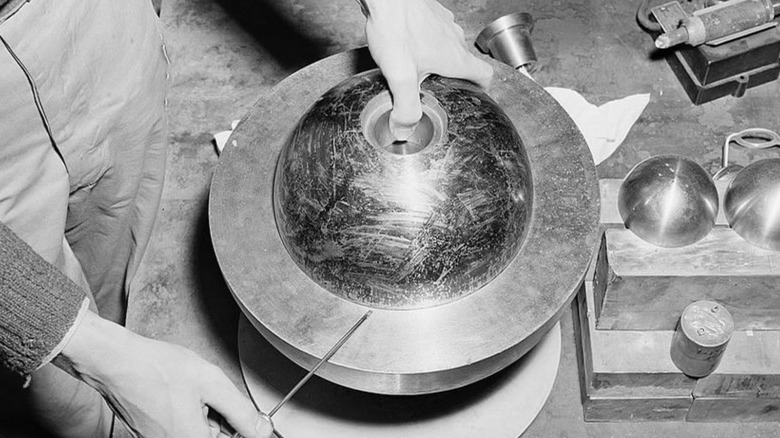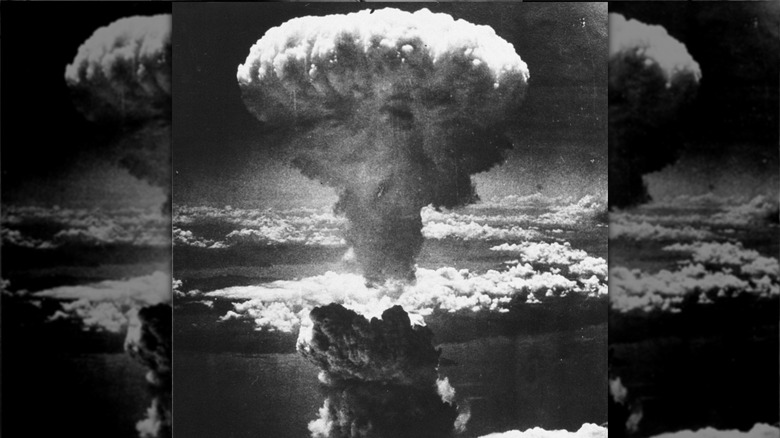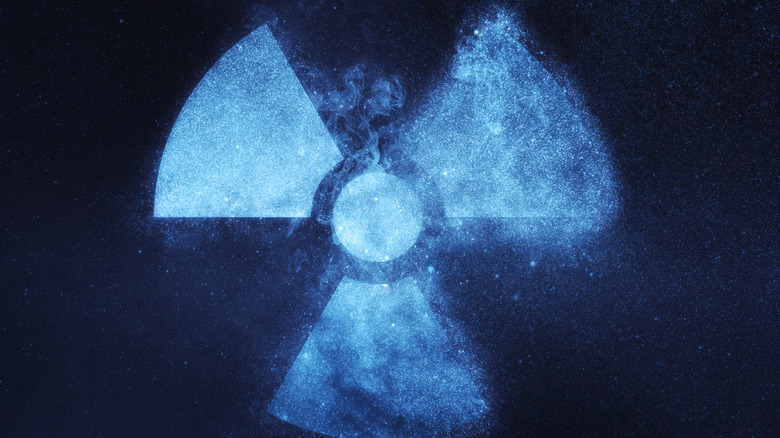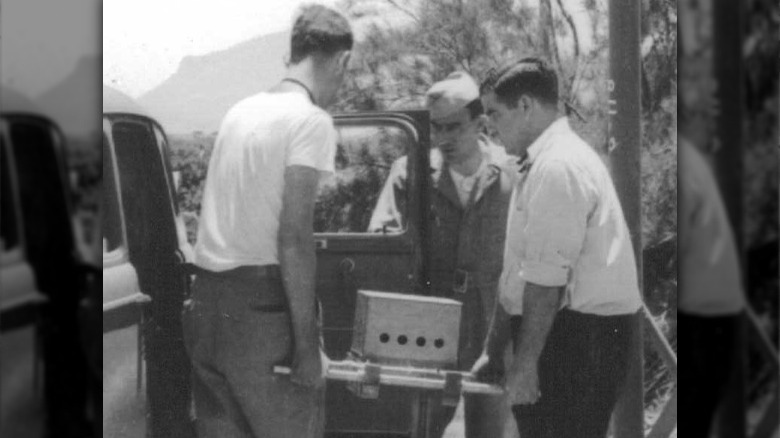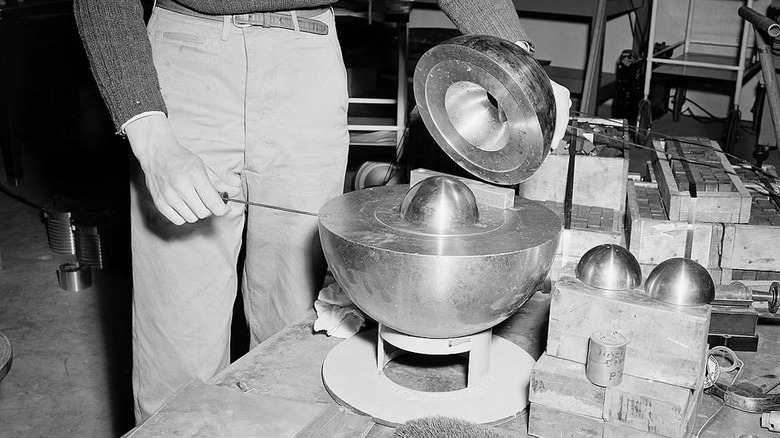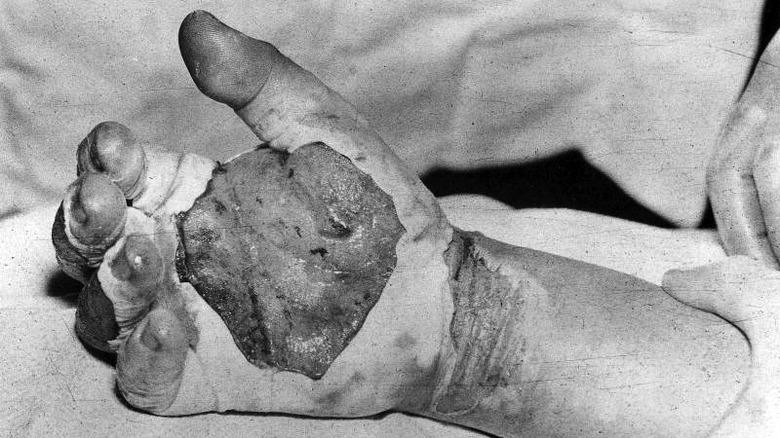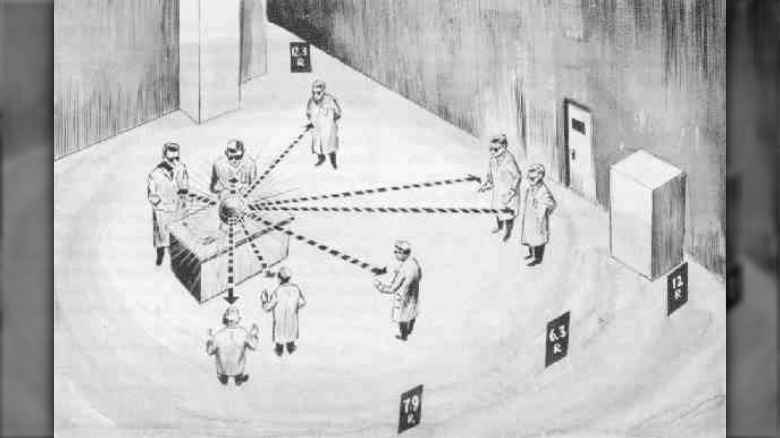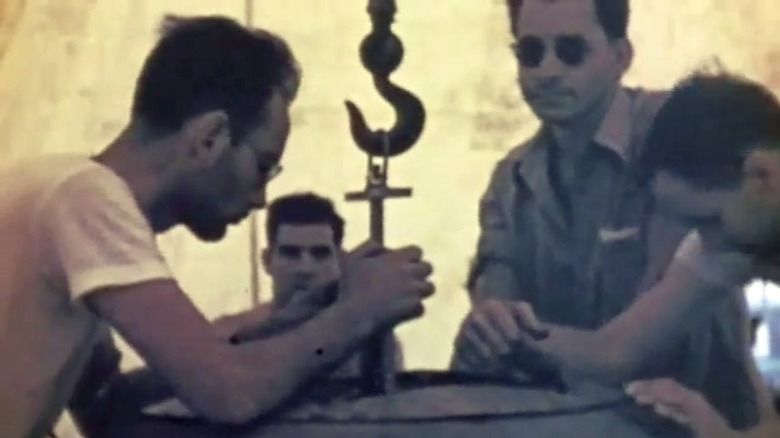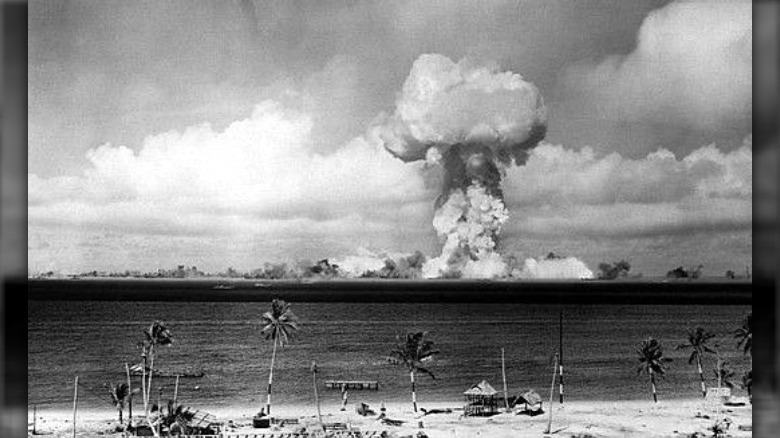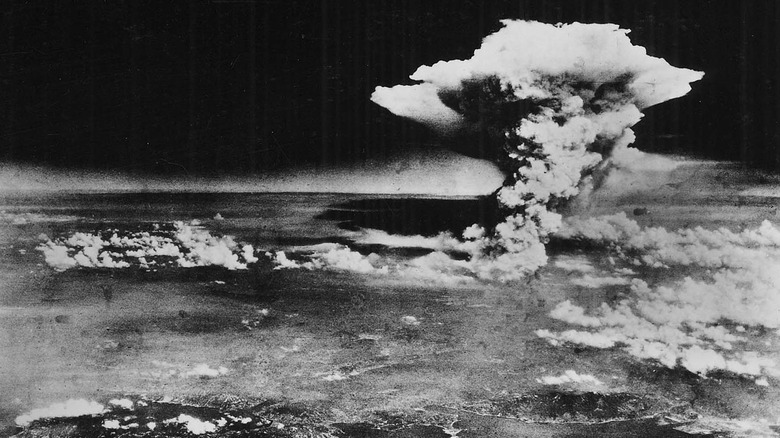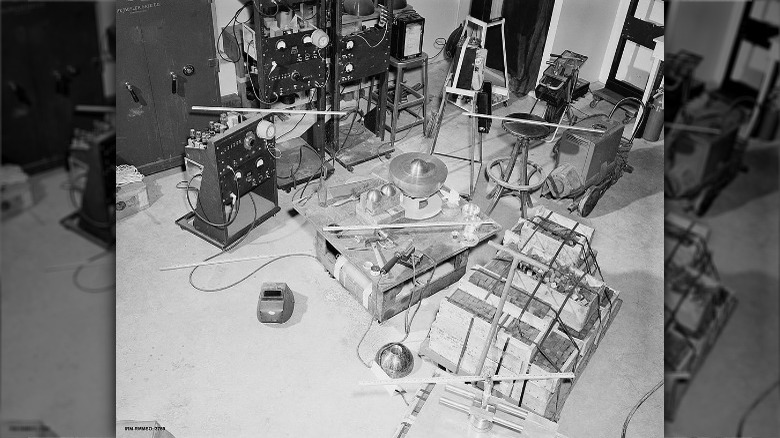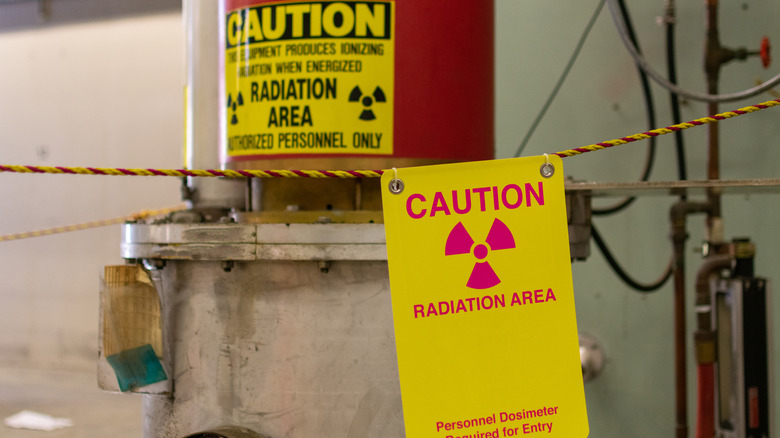The Disturbing History Of The Demon Core Nuclear Accidents
Imagine a little sphere of metal, about 14 pounds in terms of weight and 3-and-a-half inches in diameter. Nothing too strange about that, right? Maybe that sphere of metal seems a bit denser than usual, but all of that sounds pretty harmless so far.
Now, replace whatever metal you're thinking of with radioactive plutonium. Undoubtedly, that just changed a lot with regard to your mental image, didn't it? The knowledge that some material is radioactive does tend to do that, and it probably conjures up some scary situations surrounding just what that radiation can do to the very squishy human body.
History is most likely the thing to be thanked for that correlation between radiation and fear: Fukushima, Chernobyl, Nagasaki, Hiroshima, all of those familiar names. But there's another incident – or, set or incidents, rather – that deserve to be on that list, and those are the accidents that occurred surrounding the infamous demon core at Los Alamos National Laboratory. Despite those particular accidents not having quite as large a casualty list, the demon core did take multiple lives, and it's one pretty dark tale from the early years of the Cold War.
The perceived urgency of nuclear research
With the dawn of the nuclear age and the dropping of the atomic bomb on Japan, it was pretty clear that times were really changing. After all, the threat of another nuclear bomb – or better access to nuclear research – was quite the powerful bargaining tool.
It's a phenomenon that the Office of the Historian refers to as "Atomic Diplomacy." In the mid-1940s, the U.S. was fairly self-assured in its monopoly on nuclear weapons, and the deadly show of power on the cities of Hiroshima and Nagasaki was intended as just that: shows of power. It became a way for the U.S. to ensure its continued importance on the world stage. The threat of nuclear annihilation would hopefully intimidate the Soviet Union into relative submission and also coerce other European countries to align with the U.S. Of course, this would eventually go both ways. Many other countries – the Soviet Union, included – would develop nuclear weapons shortly after. The U.S. could fly bombers over Soviet-aligned countries, but then the Soviets were also capable of planting nuclear weapons in Cuba, instituting American panic (the Cuban Missile Crisis, anyone?)
Strangely, though, the diplomatic issues weren't the only factor pushing nuclear research. According to the Bulletin of the Atomic Scientists, despite all the terrible consequences of worldwide nuclear war, there weren't too many moral qualms with dropping a bomb. It was exactly the opposite; word even has it that those researchers cheered when the bomb was dropped on Japan. They wanted to see their work through to the end and desperately wanted to know if their work would amount to anything, at all costs.
What's supercriticality?
So, given that doing research into all things nuclear was the hot topic of the early days of the Cold War, what was it that scientists actually wanted to look into with the demon core? After all, they had this big lump of radioactive metal, so what were a bunch of daring and ambitious (and, perhaps, sort of naive) scientists to do?
Well, the word that you'll see thrown around a lot when it comes to the demon core and its deadly experiments is "supercriticality." And to understand that, let's get into some of the nitty-gritty science stuff. According to ThoughtCo, "criticality" isn't as scary as it sounds; it's the normal state of operations for something like a nuclear power generator. The fission reaction that splits atoms is controlled and in a balanced state, leaving it relatively safe.
Supercriticality is where things are different. In the case of the demon core, researchers wanted to go further, pressing the limits of criticality, right up to the point before it would go supercritical and the fission reaction would suddenly ramp up in speed, releasing a deadly burst of radiation. Ideally, those researchers wanted to see just how far they could go before the core blasted them with radiation (via ScienceAlert) – they wanted to see just how close they could stand to the edge before falling off, in essence – and they would've likely been hoping to monitor the core closely enough to ensure no external factors made things get too dicey (via IFLScience). Unfortunately for them, though, when you're playing with (metaphorical) fire, well, everyone knows what's coming next.
Harry Daghlian's experiment
The experiments on criticality performed on the demon core started just shortly after it was denied its chance to be fitted into a bomb. Or, really, the first accident that the demon core was involved in came almost immediately after the end of the war in the Pacific.
On August 21, 1945, barely a week after Japan's surrender, physicist Harry Daghlian decided to start those criticality tests (via ScienceAlert). He walked into the lab effectively alone, accompanied by only a security guard – already a breach of safety protocols, which was only the start of the problems to come. Daghlian started what IFLScience calls a "neutron reflector experiment," in which he surrounded the core with a bunch of reflective tungsten carbide bricks. The bricks were intended to knock neutrons back at the core, nudging it closer to supercriticality. Daghlian was monitoring the state of the core, and as he saw it teeter right on that edge, he began pulling the bricks away.
Unfortunately for him, things went badly from there. He accidentally dropped one of the bricks into the core – which, according to The Atlantic, regularly sat at a "-5 cents" configuration, just on the brink of going supercritical anyway – and there's no way dropping a brick into an unstable chunk of radioactive metal can go well. The core went supercritical, sending out a blast of blue light and intense heat. Daghlian pulled the brick away, but the damage had already been done, both he and the security guard being hit with radiation (though only Daghlian's would prove to be fatal).
Louis Slotin also experimented on the demon core
The demon core wouldn't have quite the infamy that it does if it had only been involved in a single accident. No, there were two, with the second coming in relatively quick succession after the first.
That second accident was the work of Louis Slotin, who went into the Los Alamos lab less than a year after Harry Daghlian, on May 21, 1946 (via ScienceAlert). Slotin was conducting a very similar experiment to that of Daghlian: partially covering up the plutonium core with reflective material in order to reflect neutrons back at it, seeing how close he could get to supercriticality. But, per The Atlantic, his experiment was just a slight bit different. Rather than tungsten carbide bricks, he was making use of a beryllium dome, which he balanced with his left hand while keeping part of the dome lifted (providing a vent for neutrons so that the core didn't actually go supercritical). And the tool he was using to keep the dome open? The safest tool for nuclear experimentation: a screwdriver.
You can probably see why things went badly. The screwdriver slipped, and the core was covered completely, going supercritical. Much like before, the core blasted out a wave of heat, blazing a brilliant blue that other scientists in the room claimed was bright enough to be "clearly visible" even in the well-lit lab. Slotin managed to flip the dome off of the core rather quickly, but, again, just like before, the damage had already been done.
The results of the demon core accidents weren't pretty
Harry Daghlian and Louis Slotin were both subject to lethal levels of radiation during their respective experiments, but those explosions of radiation didn't kill them immediately. No, their deaths were slow, painful, and gruesome. So, a bit of a heads up for potentially unpleasant medical stuff.
Immediately after the first incident, Daghlian purportedly felt a tingling sensation in the hand he used to knock the fallen brick out of the core (via ScienceAlert), though that would be far from the end of his problems. Per the American Physical Society, his deterioration to follow was horrifying. He suffered from nausea, abdominal pains, and diarrhea, his body emaciated by the time he slipped into a coma. The skin of his chest had reddened and begun to peel off in thick layers, though the most famous image (pictured above) is his hand, blistered and with the skin of his palm sloughed off completely. He died 25 days after the accident.
Slotin fared no better. He reported the same tingling in his hand, which eventually led to episodes of nausea. Both his physical and mental state began to quickly deteriorate – confusion, blistering, even gangrene – and press releases from the time called his condition "three-dimensional sunburn." Despite a brief glimmer of hope that he might recover, Slotin died only nine days after his accident, following "a total disintegration of bodily functions."
Harry Daghlian and Louis Slotin weren't the only victims of the demon core
When you're looking into the story of the demon core, you mostly run into the names Harry Daghlian and Louis Slotin, especially when it comes to the victims of these two terrifying nuclear accidents. But they might not have been the only ones affected by these accidents. After all, they weren't the only people in the room.
In Daghlian's case, he was performing the experiment alone, though it's definitely worth noting that the security guard who accompanied him did receive some (non-lethal) dose of radiation (via ScienceAlert). But Slotin was accompanied by a whole team of scientists. The American Physical Society explains that Slotin did his best to shield many of his coworkers from the blast with his own body, but they did still get hit with radiation. Though the exact amount wasn't documented, Smithsonian Magazine adds that a scientist who stood about three feet away would've been dosed with 90 to 100 rads – about one-tenth of Slotin's lethal dose.
So what came of those non-lethal doses? In the case of the scientists accompanying Slotin, Smithsonian Magazine claims that two of them would die about two decades later due to long-term complications of that exposure. That said, Nevada Technical Associates doesn't fully agree; while two of the scientists present did die later of leukemia (one 19 years later, the other 29 years later) the cancer wasn't necessarily linked to that radiation. Since so many years passed between the accident and their deaths, it's hard to say for sure whether the demon core was to blame.
There are some weird connections between the two accidents
It's no secret that people will enjoy breaking their brains over bizarre coincidences. After all, just take a look at the connections people cite between the JFK and Lincoln assassinations (even if, per The Washington Post, they're pretty meaningless connections and surface-level ones, at that). As it turns out, the demon core incidents have some level of that peculiarity, even if there aren't quite as many connections.
ScienceAlert points out those connections, starting with the fact that both accidents took place on Tuesday the 21st – Daghlian's incident on August 21, 1945, and Slotin's on May 21, 1946 – exactly nine months apart from each other. (That said, the more tragic detail is the fact that both incidents took place over the course of less than a year).
The really dark thing, though? Slotin and Daghlian were coworkers – unsurprising, given that they both worked at the same lab. But Slotin had actually gone to comfort Daghlian while he was dying, which meant that he'd seen the effects of lethal radiation exposure firsthand. So the moment his accident occurred, he knew exactly what future was waiting for him. And the location where Slotin died proved to be familiar, too; he apparently ended up dying in the same hospital room as Daghlian had.
The end of the demon core
For a nuclear core that so infamously caused multiple gruesome deaths, the actual ending to its story is actually, surprisingly, a bit hazy. After the demon core caused a second death, it was pretty clear that it wasn't to be used for any more of these criticality tests – for one, it had earned the ominous name of "demon core," but there were also questions in the air about its safety after having absorbed a bunch of extra neutrons over the course of those tests (via Nevada Technical Associates).
So what happened to it, instead? According to Professor Alex Wellerstein, one popular version of the story said that the core was shipped off to be a part of Operation Crossroads in July 1946. It was fitted into a bomb assembly and detonated over a bunch of empty ships in the Bikini atoll (shown above). A successful test of nuclear power (though journalists apparently dubbed it a "flop") and the end of the demon core.
But that might not have actually been the truth. Wellerstein later updated his story, explaining that the demon core was only scheduled to go to Crossroads. It'd undergone the necessary inspections, but, ultimately, it never actually got sent out to the Bikini atoll. The reasons for that sudden change in plan aren't explicit – maybe the core was just old – but it was instead locked up in New Mexico for a short time before eventually being melted down, the plutonium getting recycled for the creation of a new nuclear core.
The demon core came from a deadly lineage
While "the demon core" is a very colorful and pretty memorable moniker, the nuclear core that caused multiple deaths at a Los Alamos research facility wasn't the only one of its kind. For that matter, it's probably not even the most well-known. Rather, it's got some very famous (or infamous, maybe) brothers. No doubt you've heard of them.
See, the demon core wasn't intentionally made strictly for in-lab research purposes. Rather, the core – nicknamed "Rufus," per IFLScience – was initially made to be used as the core for an atomic bomb. On top of that, it was perfectly poised to be used in such a way; The Atlantic adds that it was literally about to be shipped for final installment in a full-on bomb. Except it didn't.
As for why? Well, it just never had the time, what with Japan's surrender putting a close on World War II in the Pacific in August 1945 (via ScienceAlert). And, of course, you can't really look at that surrender without considering the two bombs dropped on the cities of Hiroshima and Nagasaki which took some 200,000 lives – "Little Boy" and "Fat Man". Or, if you wanted a different way to classify those bombs, they're the two final homes for the siblings of the demon core. All three of them had been intended for detonation, with the demon core being the most well-developed of the bunch and referred to as the "third shot," according to historian Alex Wellerstein (though there were potentially plans for up to seven atomic bombs).
The demon core accidents didn't need to happen
While the incidents surrounding the demon core themselves are tragic, the really tragic part of this story might be the fact that these accidents could've probably been avoided entirely and really shouldn't have happened.
Prior to both Harry Daghlian and Louis Slotin's fatal experiments, another physicist, Robert R. Wilson, was working with a team on criticality experiments with the demon core. According to the American Physical Society, those tests that Wilson was a part of were just as unregulated and dangerous – an alarming problem that Wilson took up with J. Robert Oppenheimer. Unfortunately, his work took him away from Los Alamos, so he didn't really pursue the problem. In the aftermath of the deaths of Daghlian and Slotin, though, he regretted never doing anything, feeling that he might have been able to save them. In his own words: "The incident is on my conscience."
And on the topic of Slotin, his peers were also well aware of just how dangerous his experiments were. In fact, according to IFLScience, he'd ignored multiple warnings that his experiment was too risky; Enrico Fermi even said he'd be "dead within a year." But the most accurate description might've come from Richard Feynman, who likened Slotin's experiment to "tickling the dragon's tail," a statement that really explains itself. But, just to add even more layers to this unnecessary tragedy, Slotin himself didn't even want to be a part of these tests. He had no love for nuclear research and was only conducting the experiment so that he could train a replacement, freeing him up to pursue his real interests in biophysics.
The legacy of the demon core accidents
While Harry Daghlian's accident did invite some inspection of safety procedures at Los Alamos National Laboratory, per ScienceAlert, the real changes to procedure wouldn't come until after Louis Slotin's death. But when those changes came, they would prove to be a massive revamp of health and safety measures
After the two deaths, Los Alamos put a complete stop to all of these hands-on criticality experiments. Per the American Physical Society, researchers couldn't literally manipulate radioactive material with their hands, instead using machines to remotely conduct their experiments from approximately a quarter of a mile away (via Atomic Heritage Foundation). Everyone was meant to be as far away from anything radioactive as possible, so even if there was another accident, there would be enough distance for the radiation to sufficiently dissipate – a "liberal use of the inverse-square law," as said in a memo shortly after the accidents (via The New Yorker).
Nevada Technical Associates also adds that those weren't just safety protocols put into place during the height of the Cold War, during the mad race for nuclear power. Rather, all of those protocols are still felt in the modern day, heavily influencing safety training, as well as regular inspections of nuclear facilities.
